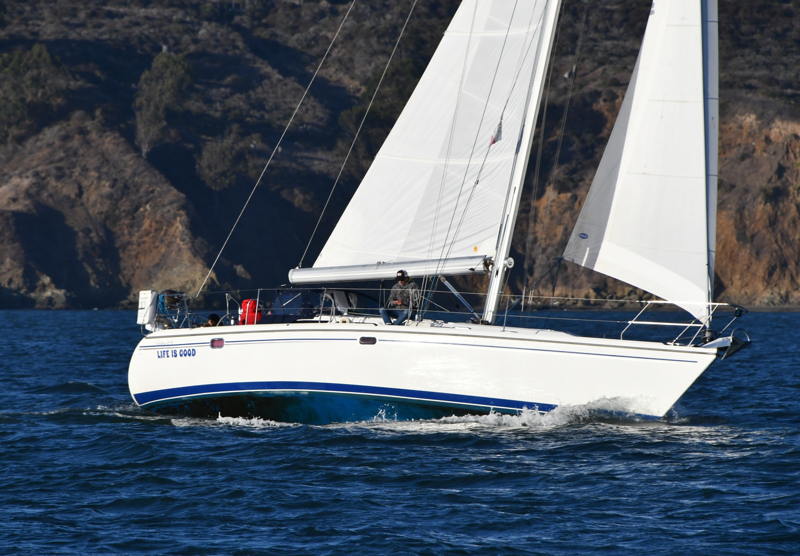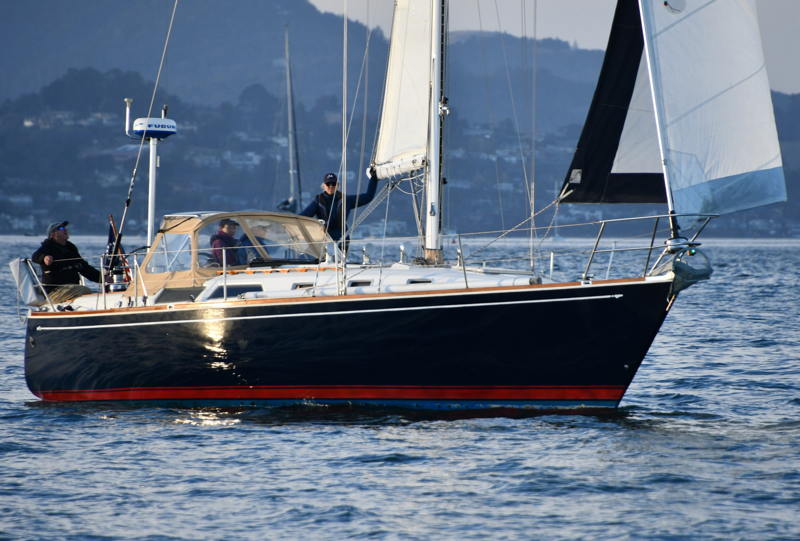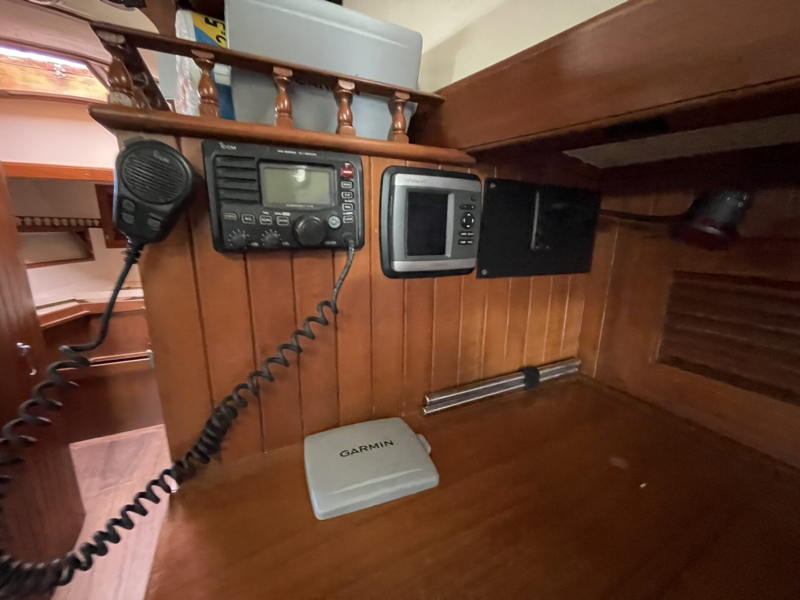
Looking Good While Sailing San Francisco Bay
We’ve been off the water for a bit, as we traveled to the Annapolis Boat Show and then to the start of the Baja Ha-Ha in San Diego. Then we had to have our leaking Navtec hydraulic backstay rebuilt and then went up the mast to replace a broken halyard. All that was finished Saturday afternoon and in time for an idyllic Sunday afternoon sail with friends. There were quite a few others out enjoying the day with gentle breezes and a flat-water flood coming in the Gate.






Speaking of the Baja Ha-Ha, most of the fleet is pulling into Bahia Santa Maria after sailing/motoring from Turtle Bay in light, warm breezes. If you haven’t been following along you can see them on the tracker here. You can also tune in as we chat with Ullman Sails’ Chuck Skewes from the deck of Profligate. The live stream is hosted by Nicki Bennett and is accessible on our Facebook page. Tune in here from 11 today.
While catching up with those offshore, you might want to check out the start of the singlehanded, nonstop, unassisted Vendée Globe race around the world. It started yesterday, also in very light air, with 40 IMOCA 60s on the starting line and now making their way south toward the Cape of Good Hope. Charlie Dalin is leading aboard Macif Santé Prévoyance and has only 23,972 miles to go until the finish. You can follow them here.
Meanwhile, here at home, it was great to be back on the Bay and see so many others out taking advantage of the great escape that’s at our doorstep.
Oh, Snap! ‘Tis the Season of King Tides
King tides are due back in the Bay Area this coming weekend, from November 15 to 17. Along with giving readers a heads-up to check their boats’ lines, we wanted to mention the California King Tides Project. The California King Tides Project is operated by the California Coastal Commission and aims to visualize future sea levels by observing the highest tides of today. We can all help by taking and sharing photos of the shoreline during king tides to create a record of changes to our coast and estuaries.
Our photos help the project team. In response, community groups up and down the coast are hosting events to observe and document the tide movements in their areas. Friday, Saturday and Sunday will see many of these groups outside across Monterey, Humboldt, Mendocino, Sonoma, San Mateo, San Luis Obispo, San Diego, Marin, and Santa Clara counties.

The events include a range of activities such as educational talks, walks, taking measurements and photos to document high water levels, and more. Each respective hosting organization is responsible for its posted event. You can see the listed events and contact details here.
If you want to take part, but don’t want to or can’t join an event, you can still help. Mark the dates on your calendar and decide where and when you’ll take your #KingTides photographs. You can find local king tide times and browse king tide photos on the California King Tides Project website. If you represent a community group or local government entity that would like to host an event for king tides, you can get in touch with [email protected].
“Your photos help us understand what’s vulnerable to flooding today, plan for future sea level rise, and get us all talking and thinking about the impacts of the climate crisis and what we can do to make a difference.”

What causes sea level rise, and what do king tides have to do with it?
“The sea level rise we’re experiencing now and will experience in the future is caused by burning fossil fuels like coal, oil, and gas. Carbon dioxide in our atmosphere acts like a blanket, trapping in heat that would otherwise escape. When we burn fossil fuels, we’re adding more carbon dioxide, ‘thickening the blanket’ and heating the Earth, air, and ocean. Sea level is rising because land-based glaciers and ice sheets are melting into the ocean, and because water takes up more space when it warms. The amount of sea level rise we will ultimately experience depends on how quickly we stop burning fossil fuels.
“King tides themselves are not caused by sea level rise, but allow us to experience what higher sea level will be like. King tides are the predicted highest tides caused by the gravitational pull of the Earth, Moon, and Sun, about a foot or two higher than average high tides, which [preview] the sea level expected within the next few decades. When you observe the king tides, picture the water level that high and higher every day. Documenting what king tides look like today will help us responsibly plan for sea level rise in the future.”

King tides aren’t new, but our ability to help understand them and plan for our future is a relatively new option available to us all.
Learn more here.
Free Haulout With Bottom Package at KKMI
- General Sailing
- Current News
- Maritime History
- Community Sailing
- Environmental News
- West Coast Sailing
A New Phase for ‘Queen of the Coast’
The Queen of the Coast left Noyo Harbor in Fort Bragg, California, on September 22 under power, and 17 hours later sailed under the Golden Gate Bridge. On the way, its crew of four encountered heavy fog that they cleared on the outside, finding light winds and mild seas under a brilliant moon. Later, they stopped to observe a large pod of gray whales and dolphins just after dawn off Point Reyes. They also had the chance to confirm the comfort and seaworthiness of this one-of-a-kind 1934, 48-ft ketch-rigged motorsailer designed by William Hand. It was now ready to begin a new phase and purpose in its 90-year journey: working as the latest project of the nonprofit Blue Frontier conservation group, “the voice of ocean action.”

Blue Frontier has worked for more than 20 years in Washington, D.C., and Richmond, California, to build the solution-oriented citizen engagement needed to protect our coasts, ocean and communities — both human and wild. Its projects have ranged from citizen campaigning that led to a White House “Ocean Climate Action Plan,” to books, a podcast, and a local effort to establish a 413-acre Point Molate Park on a wild headland in Richmond that is finally being realized.
The Queen, as Blue Frontier’s latest project, aims to bring together the wooden-boat, maritime-history and marine-conservation movements that have all depended on historically healthy seas and the classic boats that sailed upon them.
As an American yacht designer, William Hand is renowned for his early 20th-century work, particularly for his wooden motorsailers with their mix of timeless aesthetics and practicality, that has led some to refer to him as the Frank Lloyd Wright of yacht design. His vessels were greatly appreciated for being versatile and seaworthy.
The Queen (previously Libra) was built by the Wheeler Shipyard of Brooklyn, New York, in 1934. It features a pilot house with a raised forecabin and an enclosed cockpit, providing a perfect blend of functionality and comfort for long voyages. In 1942, the War Shipping Administration requisitioned the Queen and a number of other private yachts, converting them into patrol, harbor defense and coastal observation boats. William Hand’s designs were particularly appreciated by the Navy for their robust construction and rugged reliability.
It was during its three years of active service — from June 8, 1942, to September 12, 1945 — that the Queen had its gasoline engine replaced with a diesel engine, the same model used in Navy landing craft. After the war, it made its way to the West Coast. In 2004, Queen was purchased by Frank Bender, a commercial fisherman, and his wife La Rue Kobrin, a nursing professional of Fort Bragg. Over the next decade, they had cruising adventures up and down what is known as the Kelp Highway, from southeast Alaska to Baja California. After his wife passed away, Bender sold the Queen to his nephew, Robert Wright, who works out of the Sierra foothills and does some commercial fishing out of Fort Bragg. However, Queen remained docked on the Noyo River for close to a decade until, in early 2024, Wright decided to donate it to Blue Frontier, a decision heartily endorsed by his uncle.
At present Blue Frontier is fundraising to restore this historical ketch to its original condition, preserving its rich maritime heritage. It is also fundraising to train up to 18 Richmond youth as docents and trail guides for the soon-to-open Point Molate Park. As part of that training, Blue Frontier plans to take them on board the Queen, seeing the headland from the Bay and creating mixed crews, including a Marin County high school group Blue Frontier has been in touch with, hoping to encourage shared experiences and basic maritime-skills development for young people from different socioeconomic backgrounds.
The Queen will also be a platform for promoting Blue Frontier’s work around kelp forest education that includes an upcoming film (Sequoias of the Sea), a non-fiction book, and a public awareness campaign that will include educational cruising along the Kelp Highway.

As Steve Tenaglia, who captained the Queen down from Fort Bragg, puts it, “This is the kind of boat that can inspire and transform the people who get to know it.”
For further information or to make a donation, visit www.bluefront.org, or email David Schwartz at [email protected], or call (415) 302-3593.
David Helvarg is an author, executive director of Blue Frontier, an ocean-policy group, and co-host of Rising Tide: The Ocean Podcast.
You can find this and other sailing stories in Latitude 38‘s November issue.
Using Photos To Help Sell Your Boat in ‘Classy Classifieds’
We hate to see it when folks are trying to sell their boat in the Classy ads, but don’t include multiple photos. When you place your boat for sale in the Latitude 38 Classy Classifieds you can include more than one photo of your boat at no extra charge. The first photo uploaded is the one that will appear in the magazine. All the rest will appear online. As they say, a picture is worth a thousand words.
The owner of this 1986 Tayana 37 Mk II is offering her for just $20,000. Naturally, before contacting a seller, you’d like to have a little more information. It gives a prospective buyer a much better impression of the pros and cons of the boat. The written copy says it’s a project boat and gives a clear idea of what that means. That’s a great starting point for both the buyer and seller.

A couple of exterior and interior shots are a big help; shots of the engine or any other special features are also helpful. Before taking your photos make sure to clean up the boat and remove clutter — it’s the same advice you get for selling anything.

The full copy on this Tayana reads, “Bluewater cruiser, plenty of head room and storage. She is sound but is a project boat. Needs work on motor and some electrical. Batteries in good shape, all new thru hull fittings. New standing rigging, electrical wiring and LED lights, VHF antenna of this past year. Brought overland from East Coast so lifelines, stanchions and bow sprit were removed and need to be reinstalled (all included). Stainless frames for dodger and Bimini but no canvas. Sails and covers in fair condition. Interior cushions in good condition. Nice interior layout. Priced to reflect engine and other work to be completed.”

The copy gives you a good sense of what might be needed, and the photos really help you see whether this boat is one you’d want to consider buying and taking on the needed projects. There are a couple more photos of this Tayana online here.

There are many more good ideas on how to advertise your boat in John Skoriak’s article with tips on selling your boat.

It helps that the photos above were taken on sunny days so it’s easy to see the condition of the boat. The Catalina does look nice, but there’s only one photo available online, so you’ll have to get in touch with the seller to learn more. A cockpit photo and a couple of shots taken down below would probably help interest prospective buyers.
Your Latitude 38 classified ad reaches qualified sailors in print and online. The added benefit of including additional photos online is good for both buyer and seller.
To get your boat into the next issue of the magazine, make sure you submit it by the 15th of the month (coming soon!). It will go online immediately and be distributed in print about the first of the next month. You can place your classified here.
Here’s a question for our readers: “If you wanted to buy a boat, what photos of a ‘boat for sale’ would you like to see?”
Have you heard our latest Good Jibes podcast? Listen here.


